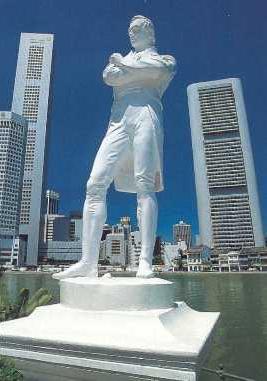
Singapore

An introduction to the geography, economy and people of Singapore.
Singapore Facts
Singapore has a tropical climate, which is hot, humid and wet. It consists of a few hundred islands south of Peninsula Malaysia (West Malaysia). Singapore is a tiny city-state (which is its own capital). Its land area is about 647.5 km² and its coastline is 193 km long. Natural disasters rarely occur here, not even flooding which happened frequently in former times. Most of Singapore's land (about 50%) is urbanised. Singapore's forest cover is limited to a few nature reserves. Flat coastal plains rise to mountains in the centre of the main island but the smaller islands are mostly flat. Singapore's coastline has changed immensely over the past 200 years or so, with reclamation going on continuously, which is why these figures on land area and coastline might not be accurate. The tallest hill, Bukit Timah, 166 m tall.
Singapore is a parliamentary democracy. The Prime Minister (Mr. Goh Chok Tong) advises the president on matters such as the appointment of the Cabinet. The Cabinet is appointed by the president, is responsible to the Parliament and deals with executive matters. The Parliament is unicameral (only one House of Parliament). In the Supreme Court, the chief justice is appointed by the president with the advice of the prime minister and the other judges are appointed by the president with the advice of the chief justice.
Singapore has a highly developed and successful free market economy, an open and corruption-free business environment, stable prices and the fifth highest per capita GDP in the world. Exports (especially in electronics and chemicals) and services are the main drivers of the economy. The government promotes high levels of savings and investment through a mandatory savings scheme and spends heavily in education and technology. As Singapore looks to a future increasingly marked by globalization, the country is positioning itself as the region's financial and high-tech hub. Singapore has practically no agriculture except for some high-tech and high-yield farms in the north. Per capita GDP in Singapore is $27,800
The population of Singapore is about 4,151,264 and the population growth rate is about 3.5%. Life expectancy is around 80 years at birth. Singapore is mainly Chinese (77%), Malay (14%) and Indian (7.6%). Other races make up the remainder of the population.
The mark of Sir Stamford Raffles is stamped on modern Singapore.
Raffles created the framework that remained the
blueprint for Singapore through generations of colonial rule and the
years of independence. This statue is at the Singapore River, on the spot which
is where he landed/is supposed to have landed in 1819. Behind, in the background
, is the Singapore skyline.

Ideally, this website should be viewed using Internet Explorer 5.